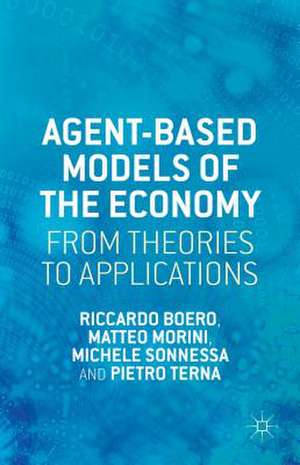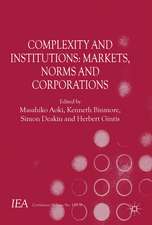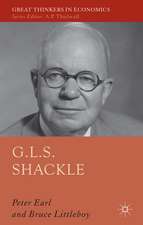Agent-based Models of the Economy: From Theories to Applications
Autor R. Boero, M. Morini, M. Sonnessa, P. Ternaen Limba Engleză Hardback – 29 iun 2015
Preț: 781.15 lei
Preț vechi: 952.61 lei
-18% Nou
Puncte Express: 1172
Preț estimativ în valută:
149.49€ • 155.18$ • 124.65£
149.49€ • 155.18$ • 124.65£
Carte tipărită la comandă
Livrare economică 24 martie-07 aprilie
Preluare comenzi: 021 569.72.76
Specificații
ISBN-13: 9781137339805
ISBN-10: 1137339802
Pagini: 210
Ilustrații: XVII, 210 p.
Dimensiuni: 140 x 216 x 14 mm
Greutate: 0.42 kg
Ediția:2015
Editura: Palgrave Macmillan UK
Colecția Palgrave Macmillan
Locul publicării:London, United Kingdom
ISBN-10: 1137339802
Pagini: 210
Ilustrații: XVII, 210 p.
Dimensiuni: 140 x 216 x 14 mm
Greutate: 0.42 kg
Ediția:2015
Editura: Palgrave Macmillan UK
Colecția Palgrave Macmillan
Locul publicării:London, United Kingdom
Cuprins
Contents I Concepts And Methods 1 Good Reasons For Agent-Based Modeling 1.1 Integration Of Theory And Data 1.2 Causality And Uncertainty 1.3 Heterogeneity And Interaction 1.4 Scalability And Modularity 1.5 Interdisciplinarity 1.6 Conclusions 2 From Complexity To Agents And Their Models 9 2.1 Searching For Roots In Complexity 2.2 Agent-Based Models 2.3 Key Characteristics Of Agent-Based Models 2.4 Weaknesses And Perspectives 2.5 Learning In Abms 2.5.1 Reinforcement Learning 2.5.2 Summarizing Learning 3 Introducing The Swarm-Like Protocol In Python (SLAPP) 3.1 Intoducing SLAPP And Swarm 3.1.1 A Graphical Representation Of The Swarm Protocol 3.2 The Swarm Protocol Step By Step Vs. The SLAPP Implementation 3.2.1 The Swarm-Like Agent Protocol In Python (SLAPP) 3.2.2 The Swarm And SLAPP Tutorials 3.3 The SLAPP Code, Following The Tutorial 3.3.1 1 Plainprogrammingbug 3.4 The Schedule As A Clock Opening Metaphorical Boxes 3.5 A Basic Example 3.5.1 The Agents Of The Example 3.5.2 Modifications To The Basic SLAPP 3.5.3 Creating The Agents Of The Model 3.6 How To Use The Model 3.6.1 The Detailed Schedule, Built Via Spreadsheet Tables 3.6.2 The Basic Sequence Of The Actions Of The Observer And Of The Model 3.7 The (Commented) Output Of Our Example 3.8 Appendix II Applications 4 Studying Human Capital Development Via Models Of Interaction In School Classes 4.1 Introduction 4.1.1 The Analysis And Its Goals 4.2 The Structure 4.2.1 The Collected Data And The Agents 4.2.2 Modifications To The Basic SLAPP 4.2.3 Creating The Agents Of The Model 4.3 How To Use The Model 4.3.1 The Detailed Schedule, Built Via Spreadsheet Tables 4.3.2 The Basic Sequence Of The Actions Of The Observer And Of The Model 4.3.3 Examples Of Use And Displayed Effects 4.4 Appendix 5 Production Organization, Recipes And Networks, With A Few Steps In Network Analysis 5.1 Introduction 5.1.1 The Analysis And Its Goals 5.2 Introducing Networks And Network Analysis In Abms 5.2.1 The Recipes As Formalism 5.2.2 Interpreting The Network Results 5.3 The Structure 5.3.1 The Illustrative Examples And The Agents 5.3.2 Modifications To The Basic SLAPP 5.3.3 Creating The Agents Of The Model 5.4 How To Use The Model 5.4.1 The Detailed Schedule, Built Via Spreadsheet Tables 5.4.2 The Basic Sequence Of The Actions Of The Observer And Of The Model 5.5 Advanced Examples Of Use And Displayed Effects 5.5.1 Adding Or Removing Nodes Via The Detailed Schedule (Script) 5.5.2 Adding Or Removing Nodes Via The Basic Sequence Of The Actions Of The Model 5.6 Concluding Remarks 5.7 Appendix 6 Simulating An Interbank Payment System 6.1 Introduction 6.2 Simulating Interbank Payments 6.2.1 Building Two Systems Working In A Parallel Way 6.2.2 Acting Upon Time 6.2.3 Choosing A Price 6.2.4 Running The Simulator 6.3 Possible Developments 7 Bottom-Up Approach To Process And Organization Designing Of Consulting Firms 7.1 Introduction 7.2 The Software And Data Analysis 7.3 The Model 7.4 Scenario Analysis 7.5 Conclusions 8 Evaluating The Introduction Of Deductibles In Health Insurance System 8.1 Deductibles In Health System 8.2 The Model 8.2.1 Policymaker 8.2.2 Physician 8.2.3 Patient 8.3 Data Collection And Function Estimation 8.3.1 The Price Response Probability Function Estimation 8.3.2 The Prescription Propensity Function Estimation 8.3.3 The Overlook Function Definition 8.4 Simulation Tool 8.5 Output Analysis 8.6 Scenario Analysis 8.7 Results 8.8 Conclusions 8.9 Acknowledgments 9 Ex-Ante Evaluation Of Public Policies: Unintended Results Of Broadband Development 9.1 Introduction 9.1.1 The Policy Question 9.1.2 The Dilemma Of The Rural Impact Of Broadband 9.1.3 The Research Approach 9.2 An Input-Output Agent-Based Model 9.2.1 The Modeling Of Broadband Impacts 9.3 Results 9.4 Conclusions 10 Economic Impacts Of Lack Of Coordination In The Governance Of Public Policies 10.1 Introduction 10.2 The Challenge Of Vertical Coordination Among Layers Of Government 10.3 A Case Study On Public Policies In Italian Local Governments 10.3.1 Research Questions And Methodology 10.3.2 An Agent-Based Model Of The Local Economy 10.3.3 The Coordination Dilemma 10.3.4 An Agent-Based Model Of Coordination 10.4 Results: Dynamics And Impacts Of Vertical Coordination 10.5 Conclusions 11 Equality And Fiscal Systems 11.1 Introduction 11.1.1 Tax System Optimization 11.1.2 Case In Point: Italy's Personal Income Tax 11.2 The Model 11.2.1 Introducing An Equity-Efficiency Trade-Off 11.2.2 Beyond A Static Micro-Simulation 11.2.3 Responsive Agents 11.2.4 Social-Local Effects: Interacting Agents 11.3 Optimization 11.3.1 The Static Model, Extended 11.3.2 Exploring The Solutions Space 11.4 The Dynamically-Optimized In-Equilibrium Scenario 11.5 Appendix 11.5.1 Model And Genetic Algorithm Parameters 12 The Emergence Of Cooperation 12.1 Introduction 12.2 The Model 12.2.1 Individual Heterogeneous Behaviour 12.2.2 Natural Selection 12.2.3 Interaction 12.3 Experimenting With Parameters 12.4 Appendix 12.4.1 Decision Tree Index
Notă biografică
Riccardo Boero holds a PhD in Economics (University of Pavia, Italy) and a PhD in Sociology (University of Surrey, UK). He has worked in several academic departments, research centers and local governments in Europe. He now works at Los Alamos National Laboratory. He serves in the editorial board of the Journal of Policy & Complex Systems - JPCS - and of the Journal of Artificial Societies and Social Simulation - JASSS. His research interests are in the fields of Computational Social Science, Experimental Economics and Industrial Economics.
Matteo Morini is a research technician at the University of Torino (Italy) and a PhD candidate at the École Normale Supérieure de Lyon (France); his research interests are in the fields of Agent-Based Modelling, Complex Systems and Complex Networks; he teaches courses on Complexity and Agent-Based Models at the Collegio Carlo Alberto Master in Economics and Complexity in Moncalieri (Italy) and is an avid Linux user.
Michele Sonnessa holds a PhD in Economics (University of Torino, Italy). He now works as a temporary researcher at Department of Economics, University of Genova. He is also an entrepreneur, with a working experience in computer software development and system design. His main interest concerns the comparison and the integration of different simulation techniques, such as System Dynamics, Process Simulation and Agent-Based Modelling and their applications to business. He is administrator of the JASproject (http://www.jasimulation.org). His research interests are in the fields of Computational Social Science, Simulation Techniques and Health Economics.
Pietro Terna is a retired professor of the University of Torino (Italy), where he was a full professor of Economics. His research work is in the fields of (i) artificial neural networks for economic applications, (ii) social simulation with agent-based models (where he has been pioneering the use of Swarm, www.swarm.org), and (iii) simulation of enterprises and organizations behavior, also in the financial domain, with studies on systemic risks with co-authors of the Italian Central Bank. He has prepared a new agent-based simulation tool in Python (Swarm-Like Agent Protocol in Python), SLAPP, deriving it from the Swarm project. He is teaching a course of Simulation Models for Economics in the Master Degree in Economics of the University of Torino. Publications and projects at http://web.econ.unito.it/terna
Matteo Morini is a research technician at the University of Torino (Italy) and a PhD candidate at the École Normale Supérieure de Lyon (France); his research interests are in the fields of Agent-Based Modelling, Complex Systems and Complex Networks; he teaches courses on Complexity and Agent-Based Models at the Collegio Carlo Alberto Master in Economics and Complexity in Moncalieri (Italy) and is an avid Linux user.
Michele Sonnessa holds a PhD in Economics (University of Torino, Italy). He now works as a temporary researcher at Department of Economics, University of Genova. He is also an entrepreneur, with a working experience in computer software development and system design. His main interest concerns the comparison and the integration of different simulation techniques, such as System Dynamics, Process Simulation and Agent-Based Modelling and their applications to business. He is administrator of the JASproject (http://www.jasimulation.org). His research interests are in the fields of Computational Social Science, Simulation Techniques and Health Economics.
Pietro Terna is a retired professor of the University of Torino (Italy), where he was a full professor of Economics. His research work is in the fields of (i) artificial neural networks for economic applications, (ii) social simulation with agent-based models (where he has been pioneering the use of Swarm, www.swarm.org), and (iii) simulation of enterprises and organizations behavior, also in the financial domain, with studies on systemic risks with co-authors of the Italian Central Bank. He has prepared a new agent-based simulation tool in Python (Swarm-Like Agent Protocol in Python), SLAPP, deriving it from the Swarm project. He is teaching a course of Simulation Models for Economics in the Master Degree in Economics of the University of Torino. Publications and projects at http://web.econ.unito.it/terna














